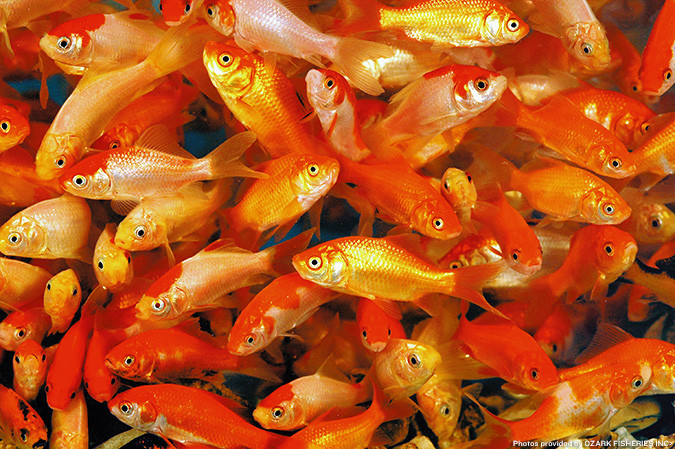It started with trout.
That’s right, one of the country’s largest goldfish producers began by raising trout. But it didn’t last long.
“He probably didn’t see it as being very profitable,” says Larry Cleveland, whose grandfather Lawrence Bailliere started Ozark Fisheries Inc. in 1926.
Bailliere, a Tulsa oilman, and his dentist friend bought 97 acres in what was Wet Glaize, northeast of Lebanon. They developed pond after pond, employing horse teams and slip scoops, shovels and wheelbarrows.
But remote Missouri made it costly to get fish to market and demand was volatile.
Goldfish, though, they discovered five-and-dime stores wanted the small, orange swimmers year-round.
The family has stuck with goldfish – both common and fancy varieties – for 88 years. The company has added koi fish, too, and now about two-thirds of the fish end up in home aquariums and one-third go to outdoor fish pools.
Hatch and catch
Stoutland is now home to the fish farm.
Ozark Fisheries’ dirt pond tally is up to 350 in Missouri, Cleveland says. That’s a pond for each of Stoutland’s 200 residents, with almost enough to go around a second time.
Cleveland is the company’s president and chairman of the board. His son, Joseph, oversees another 250 ponds in Indiana, where a second operation has been in place since an acquisition in 1970.
“The fish we sell will spend 99 percent of their time in a dirt pond,” Cleveland says. “It’s a pretty wild environment.”
On the company’s 7,000-acre grounds, spawning takes place in indoor hatcheries, where the fish live for two days before going out to stock the ponds. Sales usually are executed when the fish are 90-120 days old.
Trying to put a number on fish production is challenging. First, the family talks discreetly about its privately held business. Second, not all fish produced survive to market.
“We lose so many out in the wild,” Cleveland says of threats by animals, birds and parasites. “We’re basically fighting Mother Nature doing what we’re doing.”
To be sure, fish volume is in the tens of millions.
“It takes a whole lot more than that that you have to hatch out and spawn,” Cleveland adds. “You have to be on top of your game and watch very closely if the fish give you a signal they are being stretched.”
Counting the losses in the wild, Ozark Fisheries breeds over 100 million fish a year, including the Indiana farm. Sales are 70 percent goldfish and 30 percent koi.
Cleveland says half-a-dozen fish farms supply the majority of goldfish and koi in the United States.
Ozark Fisheries’ main competitors are Mt. Parnell Fisheries Inc. in Pennsylvania, Hunting Creek Fisheries in Maryland, Blue Ridge Fish Hatchery in North Carolina and Billy Bland Fishery in Arkansas.
Before Nemo and Dory end up on store shelves or in home aquariums, Ozark Fisheries sells the fish to wholesalers – about 350 deep. Cleveland says some of its largest buyers are Aquatics Inc., Pet Supplies Plus, Holmes Farms and Tropical Warehouse.
“If Ozark has trouble supplying, we’ll go to Mt. Parnell,” says Aquatics Inc. General Manager Tony Lullo.
But the bulk of Aquatics’ buys are with Ozark Fisheries, and it’s a relationship that dates back at least 30 years. Lullo says the supplier arranges a weekly delivery from its Indiana farm for about 40,000 of the small goldfish each week. Aquatics spends nearly $4,000 on the truckload of 1.5-inch “feeders,” along with some 3-inch varieties, such as comets, shubunkins and calicos.
“That’s basically what they’re used for to feed other fish and maybe at carnivals,” Lullo says. “We do buy the big ones, too, but not in that kind of quantity.”
Aquatics primarily sells the goldfish to some 215 Meijer grocery stores across the country.
Global matters
Ozark Fisheries’ business does have an international component.
A Wall Street Journal article in 1979 cited the United Kingdom, France and West Germany among the company’s sales markets. But Cleveland says international buyers have turned into more hassle than they’re worth managing exchange rates, inspection requirements and paperwork.
Weekly shipments to nearly 10 customers in Western Europe came to end in the late 1990s.
“It just got to be riskier and risker doing that business so far away,” he says.
Now, it’s a couple times a year. The Canadian market has filled the gap, with about 10 customers across the border.
With fish husbandry four generations deep, the 60-year-old Cleveland hopes the business remains in the family; it’s owned by five stockholders: he and his siblings and their mother. Cleveland’s son is 28 years old.
“As young as he is there is a good likelihood we could be doing this another 50 years,” he says.
